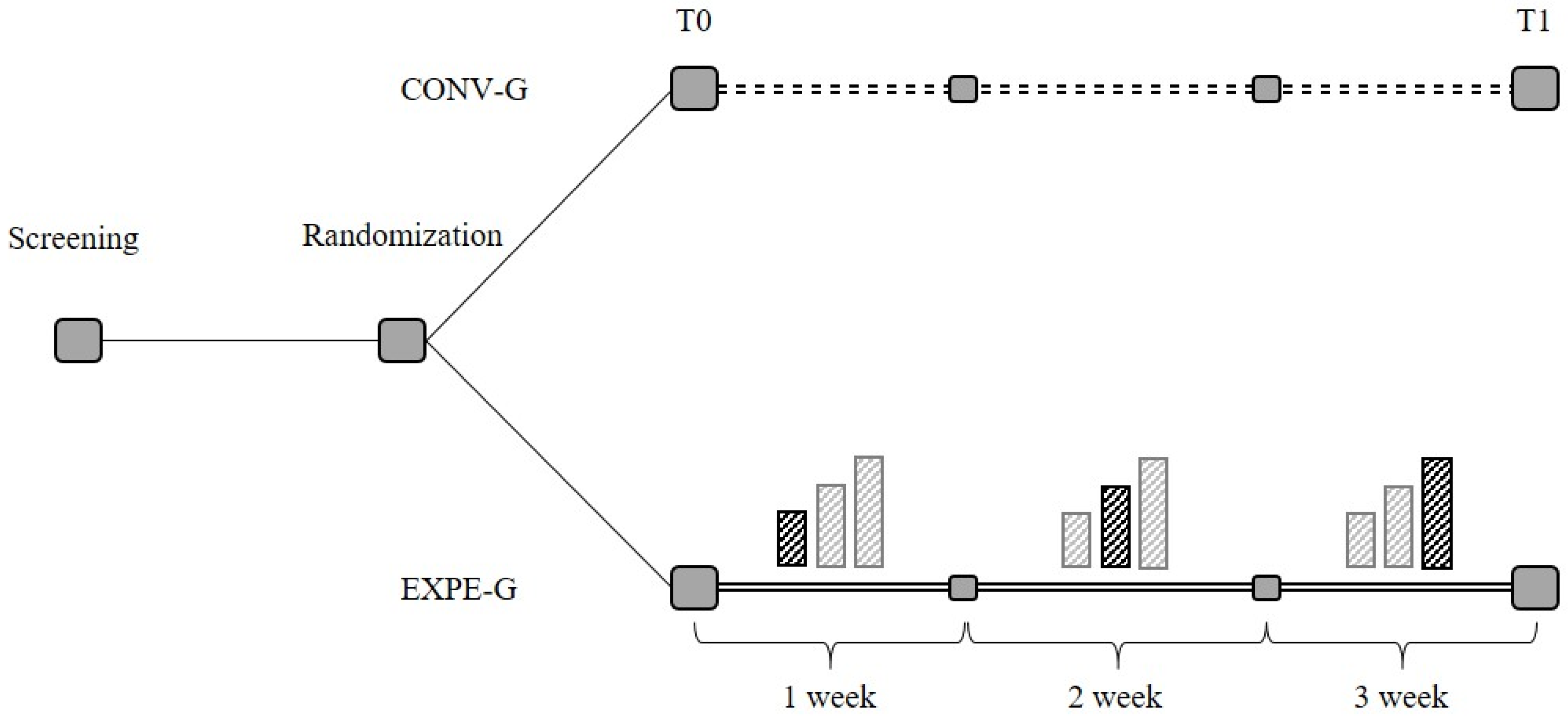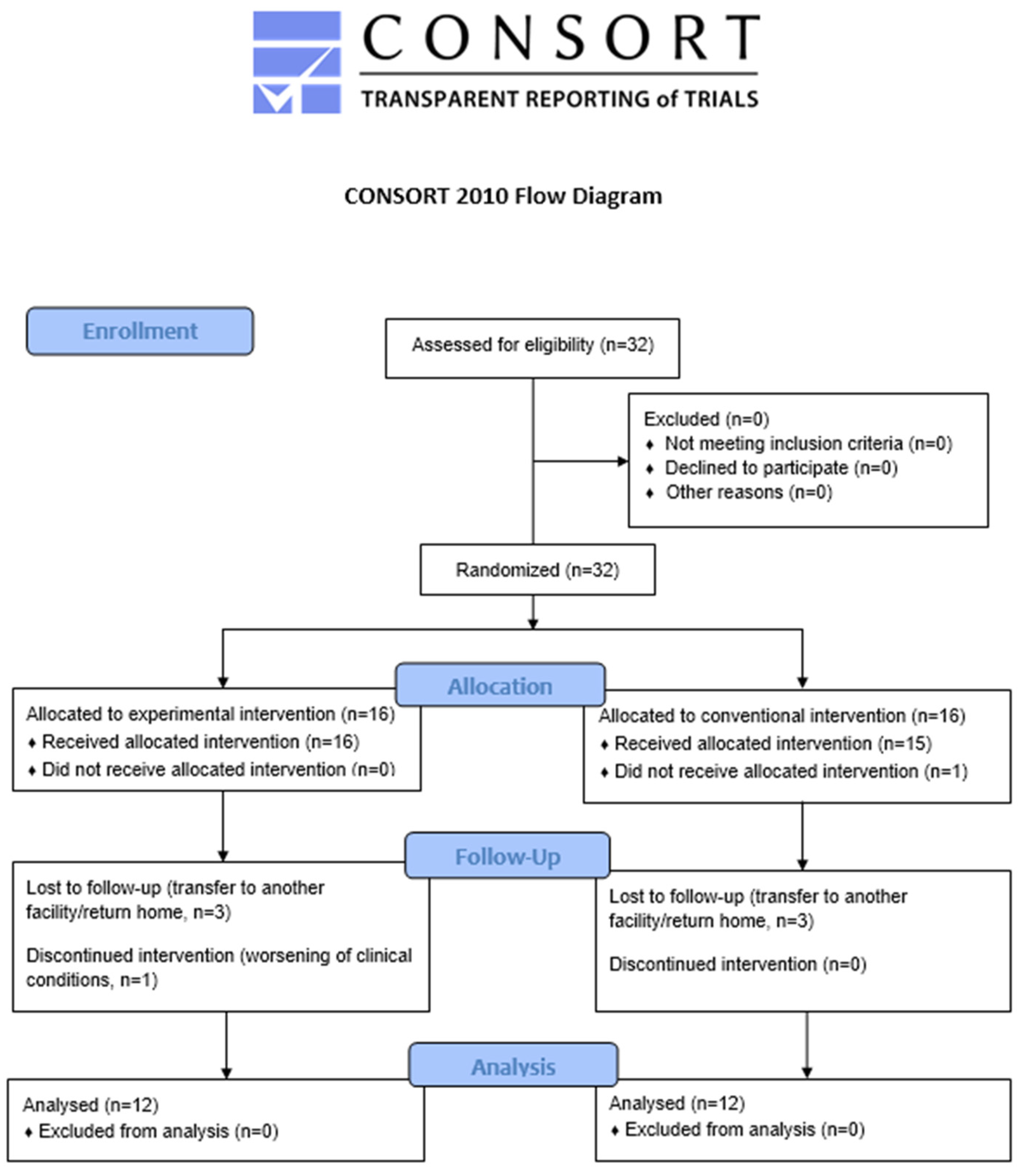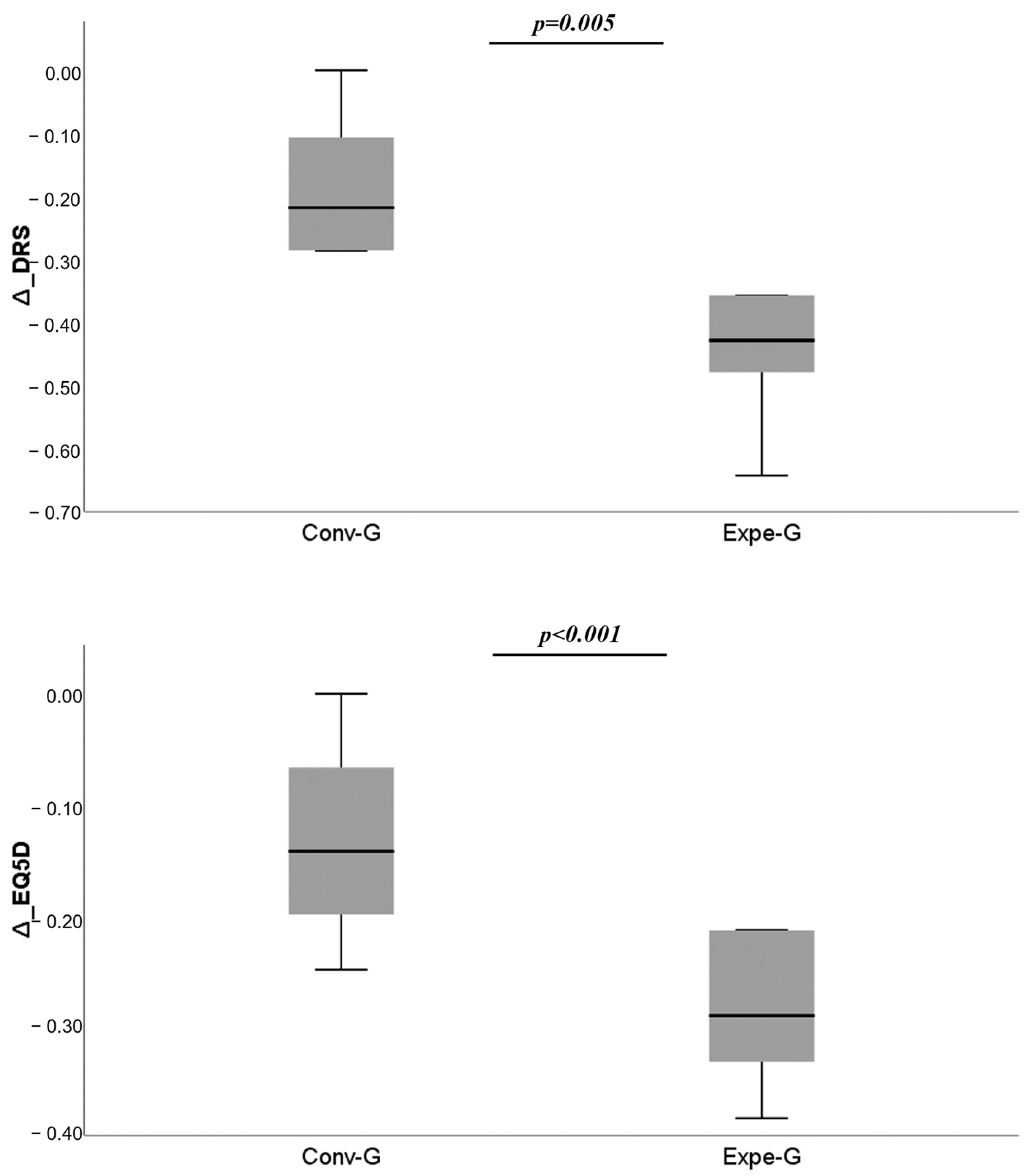The Role of Technological Rehabilitation in Patients with Intensive Care Unit Weakness: A Randomized Controlled Pilot Study
Abstract
1. Introduction
2. Materials and Methods
2.1. Protocol
2.2. Interventions
2.3. Assessment
2.4. Statistical Analysis
3. Results
4. Discussion
5. Conclusions
Author Contributions
Funding
Institutional Review Board Statement
Informed Consent Statement
Data Availability Statement
Conflicts of Interest
References
- Latronico, N.; Bolton, C.F. Critical Illness Polyneuropathy and Myopathy: A Major Cause of Muscle Weakness and Paralysis. Lancet Neurol. 2011, 10, 931–941. [Google Scholar] [CrossRef] [PubMed]
- Ydemann, M.; Eddelien, H.S.; Lauritsen, A.Ø. Treatment of critical illness polyneuropathy and/or myopathy—A systematic review. Dan. Med. J. 2012, 56. [Google Scholar] [PubMed]
- Biscetti, F.; Giovannini, S.; Straface, G.; Bertucci, F.; Angelini, F.; Porreca, C.; Landolfi, R.; Flex, A. RANK/RANKL/OPG Pathway: Genetic Association with History of Ischemic Stroke in Italian Population. Eur. Rev. Med. Pharmacol. Sci. 2016, 20, 4574–4580. [Google Scholar] [PubMed]
- Bellaver, P.; Schaeffer, A.F.; Leitao, C.B.; Rech, T.H.; Nedel, W.L. Association between Neuromuscular Blocking Agents and the Development of Intensive Care Unit-Acquired Weakness (ICU-AW): A Systematic Review with Meta-Analysis and Trial Sequential Analysis. Anaesth. Crit. Care Pain Med. 2023, 42, 101202. [Google Scholar] [CrossRef] [PubMed]
- Yang, Z.; Wang, X.; Chang, G.; Cao, Q.; Wang, F.; Peng, Z.; Fan, Y. Development and Validation of an Intensive Care Unit Acquired Weakness Prediction Model: A Cohort Study. Front. Med. 2023, 10, 1122936. [Google Scholar] [CrossRef]
- Zhou, C.; Wu, L.; Ni, F.; Ji, W.; Wu, J.; Zhang, H. Critical Illness Polyneuropathy and Myopathy: A Systematic Review. Neural. Regen. Res. 2014, 9, 101–110. [Google Scholar] [CrossRef]
- Wang, W.; Xu, C.; Ma, X.; Zhang, X.; Xie, P. Intensive Care Unit-Acquired Weakness: A Review of Recent Progress With a Look Toward the Future. Front. Med. 2020, 7, 559789. [Google Scholar] [CrossRef]
- Vanhorebeek, I.; Latronico, N.; Van den Berghe, G. ICU-Acquired Weakness. Intensiv. Care Med. 2020, 46, 637–653. [Google Scholar] [CrossRef]
- Estraneo, A.; Loreto, V.; Masotta, O.; Pascarella, A.; Trojano, L. Do Medical Complications Impact Long-Term Outcomes in Prolonged Disorders of Consciousness? Arch. Phys. Med. Rehabil. 2018, 99, 2523–2531.e3. [Google Scholar] [CrossRef]
- Schefold, J.C.; Wollersheim, T.; Grunow, J.J.; Luedi, M.M.; Z’Graggen, W.J.; Weber-Carstens, S. Muscular Weakness and Muscle Wasting in the Critically Ill. J. Cachexia Sarcopenia Muscle 2020, 11, 1399–1412. [Google Scholar] [CrossRef]
- Patsaki, I.; Gerovasili, V.; Sidiras, G.; Karatzanos, E.; Mitsiou, G.; Papadopoulos, E.; Christakou, A.; Routsi, C.; Kotanidou, A.; Nanas, S. Effect of Neuromuscular Stimulation and Individualized Rehabilitation on Muscle Strength in Intensive Care Unit Survivors: A Randomized Trial. J. Crit. Care 2017, 40, 76–82. [Google Scholar] [CrossRef] [PubMed]
- Mukpradab, S.; Cussen, J.; Ranse, K.; Songwathana, P.; Marshall, A.P. Healthcare Professionals Perspectives on Feasibility and Acceptability of Family Engagement in Early Mobilisation for Adult Critically Ill Patients: A Descriptive Qualitative Study. J. Clin. Nurs. 2023. [Google Scholar] [CrossRef] [PubMed]
- Zang, K.; Chen, B.; Wang, M.; Chen, D.; Hui, L.; Guo, S.; Ji, T.; Shang, F. The Effect of Early Mobilization in Critically Ill Patients: A Meta-Analysis. Nurs. Crit. Care 2020, 25, 360–367. [Google Scholar] [CrossRef] [PubMed]
- Watanabe, S.; Iida, Y.; Ito, T.; Mizutani, M.; Morita, Y.; Suzuki, S.; Nishida, O. Effect of Early Rehabilitation Activity Time on Critically Ill Patients with Intensive Care Unit-Acquired Weakness: A Japanese Retrospective Multicenter Study. Prog. Rehabil. Med. 2018, 3, 20180003. [Google Scholar] [CrossRef] [PubMed]
- Verceles, A.C.; Serra, M.; Davis, D.; Alon, G.; Wells, C.L.; Parker, E.; Sorkin, J.; Bhatti, W.; Terrin, M.L. Combining Exercise, Protein Supplementation and Electric Stimulation to Mitigate Muscle Wasting and Improve Outcomes for Survivors of Critical Illness-The ExPrES Study. Hear. Lung 2023, 58, 229–235. [Google Scholar] [CrossRef] [PubMed]
- Giovannetti, A.M.; Covelli, V.; Sattin, D.; Leonardi, M. Caregivers of Patients with Disorder of Consciousness: Burden, Quality of Life and Social Support. Acta Neurol. Scand. 2015, 132, 259–269. [Google Scholar] [CrossRef]
- Katz, D.I.; Polyak, M.; Coughlan, D.; Nichols, M.; Roche, A. Natural History of Recovery from Brain Injury after Prolonged Disorders of Consciousness: Outcome of Patients Admitted to Inpatient Rehabilitation with 1-4 Year Follow-Up. Prog. Brain Res. 2009, 177, 73–88. [Google Scholar] [CrossRef]
- Giovannini, S.; Iacovelli, C.; Brau, F.; Loreti, C.; Fusco, A.; Caliandro, P.; Biscotti, L.; Padua, L.; Bernabei, R.; Castelli, L. RObotic-Assisted Rehabilitation for Balance and Gait in Stroke Patients (ROAR-S): Study Protocol for a Preliminary Randomized Controlled Trial. Trials 2022, 23, 872. [Google Scholar] [CrossRef]
- Fusco, A.; Giovannini, S.; Castelli, L.; Coraci, D.; Gatto, D.M.; Reale, G.; Pastorino, R.; Padua, L. Virtual Reality and Lower Limb Rehabilitation: Effects on Motor and Cognitive Outcome-A Crossover Pilot Study. J. Clin. Med. 2022, 11, 2300. [Google Scholar] [CrossRef]
- Aprile, I.; Conte, C.; Cruciani, A.; Pecchioli, C.; Castelli, L.; Insalaco, S.; Germanotta, M.; Iacovelli, C. Efficacy of Robot-Assisted Gait Training Combined with Robotic Balance Training in Subacute Stroke Patients: A Randomized Clinical Trial. J. Clin. Med. 2022, 11, 5162. [Google Scholar] [CrossRef]
- Aprile, I.; Guardati, G.; Cipollini, V.; Papadopoulou, D.; Mastrorosa, A.; Castelli, L.; Monteleone, S.; Redolfi, A.; Galeri, S.; Germanotta, M. Robotic Rehabilitation: An Opportunity to Improve Cognitive Functions in Subjects With Stroke. An Explorative Study. Front. Neurol. 2020, 11, 588285. [Google Scholar] [CrossRef] [PubMed]
- Imbimbo, I.; Coraci, D.; Santilli, C.; Loreti, C.; Piccinini, G.; Ricciardi, D.; Castelli, L.; Fusco, A.; Bentivoglio, A.R.; Padua, L. Parkinson’s Disease and Virtual Reality Rehabilitation: Cognitive Reserve Influences the Walking and Balance Outcome. Neurol. Sci. 2021, 42, 615–4621. [Google Scholar] [CrossRef] [PubMed]
- Aprile, I.; Iacovelli, C.; Pecchioli, C.; Cruciani, A.; Castelli, L.; Germanotta, M. Efficacy of Focal Muscular Vibration in the Treatment of Upper Limb Spasticity in Subjects with Stroke Outcomes: Randomized Controlled Trial. J. Biol. Regul. Homeost. Agents 2020, 34, 1–9, Technology in Medicine. [Google Scholar] [PubMed]
- Pazzaglia, C.; Camerota, F.; Germanotta, M.; Di Sipio, E.; Celletti, C.; Padua, L. Efficacy of Focal Mechanic Vibration Treatment on Balance in Charcot-Marie-Tooth 1A Disease: A Pilot Study. J. Neurol. 2016, 263, 1434–1441. [Google Scholar] [CrossRef]
- Camerota, F.; Celletti, C.; Di Sipio, E.; De Fino, C.; Simbolotti, C.; Germanotta, M.; Mirabella, M.; Padua, L.; Nociti, V. Focal Muscle Vibration, an Effective Rehabilitative Approach in Severe Gait Impairment Due to Multiple Sclerosis. J. Neurol. Sci. 2017, 372, 33–39. [Google Scholar] [CrossRef]
- Rodríguez-pérez, M.P.; Sánchez-herrera-baeza, P.; Cano-de-la-cuerda, R.; Camacho-montaño, L.R.; Serrada-tejeda, S.; Pérez-de-heredia-torres, M. Effects of Intensive Vibratory Treatment with a Robotic System on the Recovery of Sensation and Function in Patients with Subacute and Chronic Stroke: A Non-Randomized Clinical Trial. J. Clin. Med. 2022, 11, 3572. [Google Scholar] [CrossRef]
- Calabrò, R.S.; Naro, A.; Russo, M.; Milardi, D.; Leo, A.; Filoni, S.; Trinchera, A.; Bramanti, P. Is Two Better than One? Muscle Vibration plus Robotic Rehabilitation to Improve Upper Limb Spasticity and Function: A Pilot Randomized Controlled Trial. PLoS ONE 2017, 12, e0185936. [Google Scholar] [CrossRef]
- Ustinova, K.I.; Perkins, J.; Leonard, W.A.; Hausbeck, C.J. Virtual Reality Game-Based Therapy for Treatment of Postural and Co-Ordination Abnormalities Secondary to TBI: A Pilot Study. Brain Inj. 2014, 28, 486–495. [Google Scholar] [CrossRef]
- Levin Pt, M.F.; Weiss Ot, P.L.; Keshner Pt, E.A. Emergence of Virtual Reality as a Tool for Upper Limb Rehabilitation: Incorporation of Motor Control and Motor Learning Principles. Phys. Ther. 2015, 95, 415–425. [Google Scholar] [CrossRef]
- Murillo, N.; Valls-Sole, J.; Vidal, J.; Opisso, E.; Medina, J.; Kumru, H. Focal Vibration in Neurorehabilitation. Eur. J. Phys. Rehabil. Med. 2014, 50, 231–242. [Google Scholar]
- Verhoog, M.B.; Goriounova, N.A.; Obermayer, J.; Stroeder, J.; Johannes Hjorth, J.J.; Testa-Silva, G.; Baayen, J.C.; de Kock, C.P.J.; Meredith, R.M.; Mansvelder, H.D. Mechanisms Underlying the Rules for Associative Plasticity at Adult Human Neocortical Synapses. J. Neurosci. 2013, 33, 17197–17208. [Google Scholar] [CrossRef] [PubMed]
- Zhang, L.; Hu, W.; Cai, Z.; Liu, J.; Wu, J.; Deng, Y.; Yu, K.; Chen, X.; Zhu, L.; Ma, J.; et al. Early Mobilization of Critically Ill Patients in the Intensive Care Unit: A Systematic Review and Meta-Analysis. PLoS ONE 2019, 14, e0223185. [Google Scholar] [CrossRef]
- Menges, D.; Seiler, B.; Tomonaga, Y.; Schwenkglenks, M.; Puhan, M.A.; Yebyo, H.G. Systematic Early versus Late Mobilization or Standard Early Mobilization in Mechanically Ventilated Adult ICU Patients: Systematic Review and Meta-Analysis. Crit. Care 2021, 25, 16. [Google Scholar] [CrossRef]
- Dalton, R.E.; Tripathi, R.S.; Abel, E.E.; Kothari, D.S.; Firstenberg, M.S.; Stawicki, S.P.; Papadimos, T.J. Polyneuropathy and Myopathy in the Elderly. HSR Proc. Intensiv. Care Cardiovasc. Anesth 2012, 4, 15. [Google Scholar]
- Stevens, R.D.; Marshall, S.A.; Cornblath, D.R.; Hoke, A.; Needham, D.M.; De Jonghe, B.; Ali, N.A.; Sharshar, T. A Framework for Diagnosing and Classifying Intensive Care Unit-Acquired Weakness. Crit. Care Med. 2009, 37, S299–S308. [Google Scholar] [CrossRef]
- Kisner, C.; Allen Colby, L. Therapeutic Exercise: Foundations and Techniques, 6th ed.; F.A. Davis Company: Philadelphia, PA, USA, 2012; ISBN 978-0803625747. [Google Scholar]
- Timmermans, A.A.; Seelen, H.A.; Willmann, R.D.; Kingma, H. Technology-Assisted Training of Arm-Hand Skills in Stroke: Concepts on Reacquisition of Motor Control and Therapist Guidelines for Rehabilitation Technology Design. J. Neuroeng. Rehabil. 2009, 6, 1. [Google Scholar] [CrossRef] [PubMed]
- Fayazi, M.; Dehkordi, S.N.; Dadgoo, M.; Salehi, M. Test-Retest Reliability of Motricity Index Strength Assessments for Lower Extremity in Post Stroke Hemiparesis. Med. J. Islam Repub. Iran 2012, 26, 27–30. [Google Scholar] [PubMed]
- Collin, C.; Wade, D. Assessing Motor Impairment after Stroke: A Pilot Reliability Study. J. Neurol. Neurosurg. Psychiatry 1990, 53, 576–579. [Google Scholar] [CrossRef]
- Mehrholz, J.; Wagner, K.; Rutte, K.; Meißner, D.; Pohl, M. Predictive Validity and Responsiveness of the Functional Ambulation Category in Hemiparetic Patients after Stroke. Arch. Phys. Med. Rehabil. 2007, 88, 1314–1319. [Google Scholar] [CrossRef]
- Mahoney, F.I.; Barthel, D.W. Functional Evaluation: The Barthel Index. Md. State Med. J. 1965, 14, 61–65. [Google Scholar]
- Devlin, N.J.; Brooks, R. EQ-5D and the EuroQol Group: Past, Present and Future. Appl. Health Econ. Health Policy 2017, 15, 127–137. [Google Scholar] [CrossRef] [PubMed]
- Gouvier, W.; Blanton, P.; LaPorte, K.; Nepomuceno, C. Reliability and Validity of the Disability Rating Scale and the Levels of Cognitive Functioning Scale in Monitoring Recovery from Severe Head Injury. Arch. Phys. Med. Rehabil. 1987, 68, 94–97. [Google Scholar] [CrossRef] [PubMed]
- Schulz, K.F.; Altman, D.G.; Moher, D. CONSORT 2010 Statement: Updated Guidelines for Reporting Parallel Group Randomised Trials. BMC Med. 2010, 1, 100–107. [Google Scholar] [CrossRef]
- Devlin, J.W.; Skrobik, Y.; Gélinas, C.; Needham, D.M.; Slooter, A.J.C.; Pandharipande, P.P.; Watson, P.L.; Weinhouse, G.L.; Nunnally, M.E.; Rochwerg, B.; et al. Clinical Practice Guidelines for the Prevention and Management of Pain, Agitation/Sedation, Delirium, Immobility, and Sleep Disruption in Adult Patients in the ICU. Crit. Care Med. 2018, 46, E825–E873. [Google Scholar] [CrossRef]
- Jones, T.A. Motor Compensation and Its Effects on Neural Reorganization after Stroke. Nat. Rev. Neurosci. 2017, 18, 267–280. [Google Scholar] [CrossRef]
- Corbetta, D.; Imeri, F.; Gatti, R. Rehabilitation That Incorporates Virtual Reality Is More Effective than Standard Rehabilitation for Improving Walking Speed, Balance and Mobility after Stroke: A Systematic Review. J. Physiother. 2015, 61, 117–124. [Google Scholar] [CrossRef]
- Hornby, T.G.; Reisman, D.S.; Ward, I.G.; Scheets, P.L.; Miller, A.; Haddad, D.; Fox, E.J.; Fritz, N.E.; Hawkins, K.; Henderson, C.E.; et al. Clinical Practice Guideline to Improve Locomotor Function Following Chronic Stroke, Incomplete Spinal Cord Injury, and Brain Injury. J. Neurol. Phys. Ther. 2020, 44, 49–100. [Google Scholar] [CrossRef]
- Rosenkranz, K.; Rothwell, J.C. Differential Effect of Muscle Vibration on Intracortical Inhibitory Circuits in Humans. J. Physiol. 2003, 551, 649–660. [Google Scholar] [CrossRef] [PubMed]
- Annino, G.; Iellamo, F.; Palazzo, F.; Fusco, A.; Lombardo, M.; Campoli, F.; Padua, E. Acute Changes in Neuromuscular Activity in Vertical Jump and Flexibility after Exposure to Whole Body Vibration. Medicine 2017, 96, e7629. [Google Scholar] [CrossRef] [PubMed]
- Rittweger, J.; Beller, G.; Felsenberg, D. Acute Physiological Effects of Exhaustive Whole-Body Vibration Exercise in Man. Clin. Physiol. 2000, 20, 134–142. [Google Scholar] [CrossRef]
- Cochrane, D.J.; Stannard, S.R.; Sargeant, A.J.; Rittweger, J. The Rate of Muscle Temperature Increase during Acute Whole-Body Vibration Exercise. Eur. J. Appl. Physiol. 2008, 103, 441–448. [Google Scholar] [CrossRef] [PubMed]
- Meyer-Frießem, C.H.; Malewicz, N.M.; Rath, S.; Ebel, M.; Kaisler, M.; Tegenthoff, M.; Schildhauer, T.A.; Pogatzki-Zahn, E.M.; Maier, C.; Zahn, P.K. Incidence, Time Course and Influence on Quality of Life of Intensive Care Unit-Acquired Weakness Symptoms in Long-Term Intensive Care Survivors. J. Intensiv. Care Med. 2021, 36, 1313–1322. [Google Scholar] [CrossRef] [PubMed]
- Herridge, M.S. Legacy of Intensive Care Unit-Acquired Weakness. Crit. Care Med. 2009, 37, S457–S461. [Google Scholar] [CrossRef] [PubMed]
- Fusco, A.; Galluccio, C.; Castelli, L.; Pazzaglia, C.; Pastorino, R.; Pires Marafon, D.; Bernabei, R.; Giovannini, S.; Padua, L. Severe Acquired Brain Injury: Prognostic Factors of Discharge Outcome in Older Adults. Brain Sci. 2022, 12, 1232. [Google Scholar] [CrossRef]
- Appleton, R.T.D.; Kinsella, J.; Quasim, T. The Incidence of Intensive Care Unit-Acquired Weakness Syndromes: A Systematic Review. J. Intensiv. Care Soc. 2015, 16, 126–136. [Google Scholar] [CrossRef] [PubMed]
- Maclean, N.; Pound, P.; Wolfe, C.; Rudd, A. Qualitative Analysis of Stroke Patients’ Motivation for Rehabilitation. Br. Med. J. 2000, 321, 1051–1054. [Google Scholar] [CrossRef]
- Julious, S.A. Sample Size of 12 per Group Rule of Thumb for a Pilot Study. Pharm. Stat. 2005, 4, 287–291. [Google Scholar] [CrossRef]
- Dobkin, B.H. Progressive Staging of Pilot Studies to Improve Phase III Trials for Motor Interventions. Neurorehabil. Neural. Repair. 2009, 23, 197–206. [Google Scholar] [CrossRef]



| Expe-G (n = 12) | Conv-G (n = 12) | p-Value | ||
|---|---|---|---|---|
| Gender, n | Female vs. Male | 4 vs. 8 | 7 vs. 5 | 0.321 |
| Age, years | mean ± SD | 63.75 ± 12.29 | 62.75 ± 8.29 | 0.749 |
| Latency from acute event, days | mean ± SD | 80.58 ± 13.77 | 70.25 ± 19.51 | 0.421 |
| DRS | mean ± SD | 14.83 ± 1.53 | 15.58 ± 4.80 | 0.279 |
| MI-LL dx | mean ± SD | 43.67 ± 7.87 | 45.83 ± 26.63 | 0.472 |
| MI-LL sx | mean ± SD | 42.00 ± 5.83 | 41.67 ± 15.04 | 0.329 |
| TCT | mean ± SD | 29.17 ± 17.65 | 28.17 ± 20.33 | 0.588 |
| EQ-5D | mean ± SD | 12.00 ± 2.13 | 12.67 ± 2.87 | 0.329 |
| FAC | mean ± SD | 0.25 ± 0.45 | 0.17 ± 0.39 | 0.755 |
| mBI | mean ± SD | 16.92 ± 10.18 | 19.17 ± 10.94 | 0.559 |
| Expe-G | Conv-G | |||||
|---|---|---|---|---|---|---|
| T0 (Mean ± SD) | T1 (Mean ± SD) | p-Value (T0 vs. T1) | T0 (Mean ± SD) | T1 (Mean ± SD) | p-Value (T0 vs. T1) | |
| MI-LL dx | 43.67 ± 7.87 | 58.83 ± 13.03 | 0.002 | 45.83 ± 26.63 | 57.33 ± 25.49 | 0.007 |
| MI-LL sx | 42.00 ± 5.83 | 50.33 ± 16.02 | 0.011 | 41.67 ± 15.04 | 49.08 ± 18.72 | 0.007 |
| TCT | 29.17 ± 17.65 | 81.50 ± 14.86 | 0.002 | 28.17 ± 20.33 | 54.33 ± 25.27 | 0.007 |
| EQ-5D | 12.00 ± 2.13 | 8 ± 11.92 | 0.002 | 12.67 ± 2.87 | 11.17 ± 3.30 | 0.002 |
| FAC | 0.25 ± 0.45 | 2.42 ± 1.24 | 0.002 | 0.17 ± 0.39 | 1.75 ± 1.60 | 0.003 |
| DRS | 14.83 ± 1.53 | 8.33 ± 1.37 | 0.002 | 15.58 ± 4.80 | 12.50 ± 5.57 | 0.003 |
| mBI | 16.92 ± 10.18 | 41.75 ± 34.13 | 0.002 | 19.17 ± 10.94 | 34.58 ± 28.70 | 0.007 |
Disclaimer/Publisher’s Note: The statements, opinions and data contained in all publications are solely those of the individual author(s) and contributor(s) and not of MDPI and/or the editor(s). MDPI and/or the editor(s) disclaim responsibility for any injury to people or property resulting from any ideas, methods, instructions or products referred to in the content. |
© 2023 by the authors. Licensee MDPI, Basel, Switzerland. This article is an open access article distributed under the terms and conditions of the Creative Commons Attribution (CC BY) license (https://creativecommons.org/licenses/by/4.0/).
Share and Cite
Castelli, L.; Iacovelli, C.; Fusco, A.; Amoruso, V.; Cuccagna, C.; Loreti, C.; Giovannini, S.; Padua, L. The Role of Technological Rehabilitation in Patients with Intensive Care Unit Weakness: A Randomized Controlled Pilot Study. J. Clin. Med. 2023, 12, 2612. https://doi.org/10.3390/jcm12072612
Castelli L, Iacovelli C, Fusco A, Amoruso V, Cuccagna C, Loreti C, Giovannini S, Padua L. The Role of Technological Rehabilitation in Patients with Intensive Care Unit Weakness: A Randomized Controlled Pilot Study. Journal of Clinical Medicine. 2023; 12(7):2612. https://doi.org/10.3390/jcm12072612
Chicago/Turabian StyleCastelli, Letizia, Chiara Iacovelli, Augusto Fusco, Vincenza Amoruso, Cristina Cuccagna, Claudia Loreti, Silvia Giovannini, and Luca Padua. 2023. "The Role of Technological Rehabilitation in Patients with Intensive Care Unit Weakness: A Randomized Controlled Pilot Study" Journal of Clinical Medicine 12, no. 7: 2612. https://doi.org/10.3390/jcm12072612
APA StyleCastelli, L., Iacovelli, C., Fusco, A., Amoruso, V., Cuccagna, C., Loreti, C., Giovannini, S., & Padua, L. (2023). The Role of Technological Rehabilitation in Patients with Intensive Care Unit Weakness: A Randomized Controlled Pilot Study. Journal of Clinical Medicine, 12(7), 2612. https://doi.org/10.3390/jcm12072612










